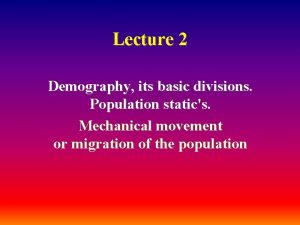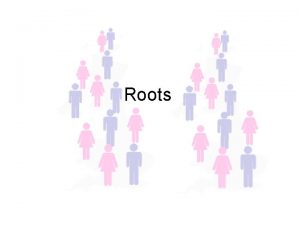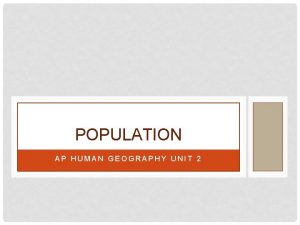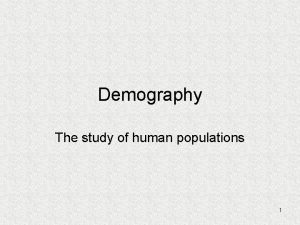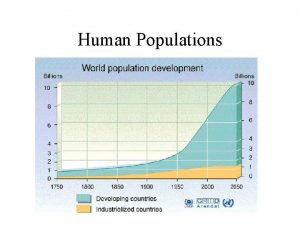Demography The Study of Population Population Issues World





















- Slides: 21

Demography The Study of Population & Population Issues

World Population Patterns

Birth Rate: # of births in a country for every 1000 people in the pop. Total births in one year population size ( in middle of year) X 1000

Birth Rate Highest B. R. - Niger 50. 54 Lowest B. R. – Japan 7. 3 Canada – 10. 28

Death Rate: # of deaths in a country for every 1000 people in the pop. Total deaths in one year X 1000 population size ( in middle of year)

Death Rate Highest D. R. – Angola 23. 4 Lowest D. R. - United Arab Emirates – 2. 06 Canada – 7. 98

Natural Increase Rate: difference between Birth Rate and Death Rate of a country BR - DR = NI http: //www. worldlifeexpectancy. com/index. php

Natural Increase

Immigration / Emigration / Net Migration Immigration Rate: # of people who permanently move to a country Emigration Rate: # of people who permanently move from a country Net Migration Rate – difference between IR and EM (IR-EM) Trinidad and Tobago -11. 2 UAE 24. 41 Canada 5. 62

Population Growth Rate: rate at which a country’s population is changing. (BR-DR) + (IR - ER) = Pop. Growth

Population Growth Rate Highest P. G. – Zimbabwe 4. 31% Lowest P. G. – Bulgaria -0. 781% Canada - 0. 794%

Dependent vs. Working Population Dependency Load: % of population that is ≤ 14 years old and 65 and older Age Dependency Ratio: ratio of people in “dependent” ages to those in the “working” ages. Dependent Population ≤ 14 + population 65+ Working Population 15 -64

Age-Dependency Ratio Highest A. D. R. - Uganda 1. 12 (11 dependent people for every 10 working) Lowest A. D. R. - United Arab Emirates - 0. 3 (3 dependent people for every 10 working) Canada – 0. 44

Infant Mortality Rate: # of children, in a country, who die in the first year of life for each 1000 live births. # of babies that died before 1 st birthday Total # of live births in middle of year X 1000

Infant Mortality Rate Highest I. M. R. - Angola 175. 9 Lowest I. M. R. – Singapore 2. 32 Canada – 4. 92

Life Expectancy: the average # of years a person is expected to live from birth. Population Pyramid: a special type of graph that summarizes the age and gender structure of a population.

Life Expectancy Highest L. E. - Japan 82. 25 Lowest L. E. – Angola 38. 8 Canada – 81. 4

Total Fertility: average # of children that each woman could have during her fertile years (15 -45)

Fertility Rate Highest F. R. – Niger 7. 6 Lowest F. R. – Singapore 1. 1 Canada – 1. 58

Replacement Rate: is the total fertility rate that produces a natural increase rate of 0. This value does not take immigration into account Standard replacement rate is 2. 1 (country’s population remains the same - no growth)

Doubling Time Rule of 70: a way to estimate how long it would take for a country’s population to double 70/country’s growth rate = number of years in which a country’s population will double
 Population demography definition
Population demography definition Static demography
Static demography Cso business demography
Cso business demography Elements of demography
Elements of demography Exclave ap human geography definition
Exclave ap human geography definition Sources of demographic data
Sources of demographic data Components of demography
Components of demography Demography antonym
Demography antonym Ethical and social issues in the digital firm
Ethical and social issues in the digital firm Facebook ethical issues case study
Facebook ethical issues case study Wrap up work immersion
Wrap up work immersion Chapter 4 population ecology test answer key
Chapter 4 population ecology test answer key Section 1 population dynamics answer key
Section 1 population dynamics answer key Population ecology section 1 population dynamics
Population ecology section 1 population dynamics Chapter 4 section 1 population dynamics study guide
Chapter 4 section 1 population dynamics study guide Hát kết hợp bộ gõ cơ thể
Hát kết hợp bộ gõ cơ thể Lp html
Lp html Bổ thể
Bổ thể Tỉ lệ cơ thể trẻ em
Tỉ lệ cơ thể trẻ em Voi kéo gỗ như thế nào
Voi kéo gỗ như thế nào Glasgow thang điểm
Glasgow thang điểm Bài hát chúa yêu trần thế alleluia
Bài hát chúa yêu trần thế alleluia

